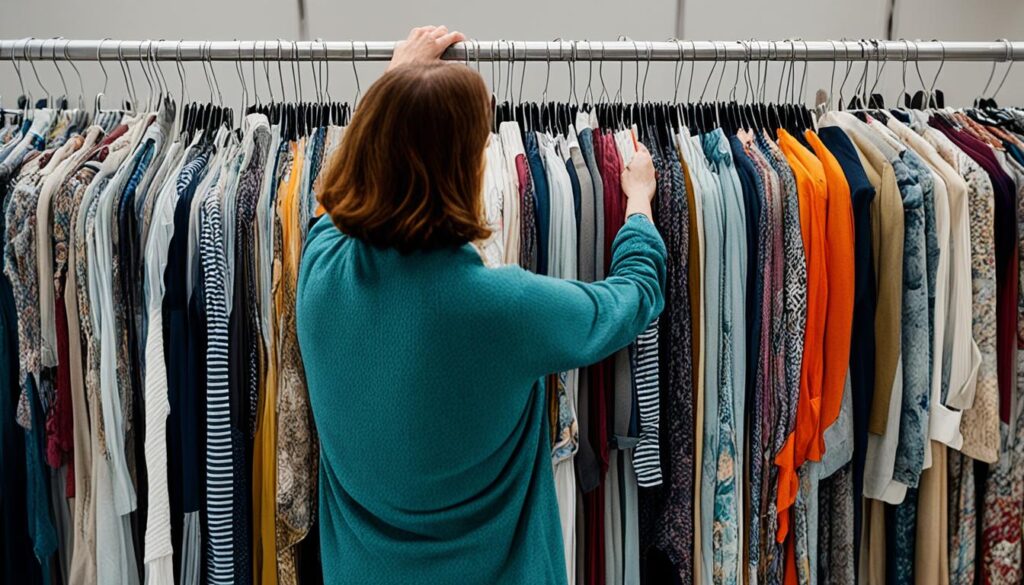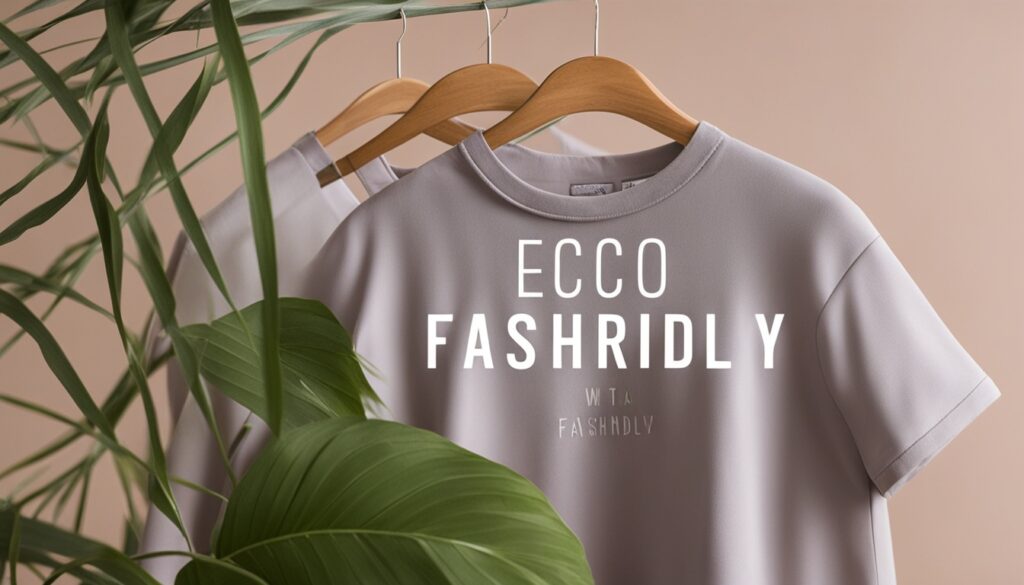The fashion world is changing fast, moving towards eco-friendly and sustainable ways. Fast fashion, with its quick production and disposal, harms the environment1. Since the 2000s, fashion production has doubled and is set to triple by 2050. Polyester, a key material in fast fashion, has grown nine times in the last 50 years1.
This growth has severe environmental effects. The fashion industry is responsible for 10% of greenhouse gas emissions and 20% of global wastewater1. To fight this, sustainable fashion is becoming more popular. It aims to lessen the harm caused by making and using clothes.
Key Takeaways
- Fashion production has doubled since the 2000s and is projected to triple by 2050.
- The fashion industry contributes 10% of human-caused greenhouse gas emissions and 20% of global wastewater.
- Sustainable fashion aims to minimize the environmental impact of clothing production and consumption.
- Consumers can make eco-friendly choices by buying less, purchasing quality, eco-friendly gear, and exploring secondhand options.
- The shift towards sustainable fashion involves using organic or recycled materials, reducing water and energy consumption, and implementing circular economy principles.
Understanding the Environmental Impact of Fashion
The fashion industry has a big environmental impact. It creates about 8-10% of global carbon emissions2. This is more than the emissions from flights and ships combined3. Making clothes is complex, involving cotton farming, dyeing fabrics, and moving goods, all adding to the emissions2.
Greenhouse Gas Emissions and the Fashion Industry
The fashion industry is a big source of greenhouse gases, adding about 10% to the global total3. This shows we need to make fashion more sustainable fast. From making materials to getting rid of clothes, fashion affects the environment a lot2.
Water Consumption and Pollution in Textile Manufacturing
Making clothes uses a lot of water, like 10,000 liters for one pair of jeans2. The industry also pollutes a lot of water, making up 20% of industrial waste3. Dyes and chemicals in making clothes pollute water, harming ecosystems and making water scarce2.
| Environmental Impact Metric | Fashion Industry Contribution |
|---|---|
| Global Carbon Emissions | 8-10% |
| Water Consumption | 93 billion cubic meters annually |
| Industrial Water Pollution | 20% |
| Microplastics Pollution | 35% of total microplastics |
The fashion industry’s impact is huge, with big emissions, water use, and pollution. Choosing sustainable fashion is key to reducing harm and protecting our planet23.
The Problem with Fast Fashion
The fast fashion industry is a big part of the global environmental crisis4. It’s responsible for about 10% of global carbon emissions, more than all international flights and maritime shipping combined4. Fashion production adds 10% to total global carbon emissions, which is as much as the European Union’s emissions4. The fast pace of fashion changes greatly affects the environment.
Short Product Lifecycles and Overconsumption
Fast fashion leads to overconsumption. The average piece of clothing is worn 36% less today than in 2000, even though production has doubled4. This means more waste because fast fashion items are often thrown away after a few uses4. In fact, 85% of textiles end up in landfills yearly, and dyeing textiles is the second-largest polluter of water4.
The fashion industry’s impact goes beyond carbon emissions4. Making leather and synthetic fibers like polyester and acrylic needs a lot of resources and takes hundreds of years to break down, adding to ocean pollution4. The industry uses a lot of water too, with one cotton shirt needing 700 gallons and a pair of jeans needing 2,000 gallons4.
Fast fashion’s overconsumption is huge4. We now buy around 80 billion new pieces of clothing every year, which is 400% more waste than twenty years ago4. The International Union for Conservation of Nature says 35% of ocean microplastics come from washing synthetic textiles4.
The fast fashion industry’s environmental impact is a big worry that needs quick action5. It makes up 8-10% of global emissions5, and UK shoppers buy the most clothes per person in Europe5. Clothes sales could jump by up to 65% by 2030, says the World Bank5.
But, there’s hope, as slow fashion is gaining ground, pushing for sustainable practices4. Renting clothes and buying secondhand are becoming popular ways to avoid fast fashion4. We need everyone – consumers, businesses, and governments – to work together to make fashion more sustainable and reduce its environmental harm.
Eco-Friendly Fabrics and Materials
The fashion industry is facing big environmental challenges. Organic cotton and plant-based fibers like hemp and flax are helping. They need less water and pesticides than regular cotton6. These natural options are better for the planet and support ethical fashion.
Recycled polyester is also becoming popular. It makes fewer emissions than new polyester6. But, synthetic fabrics can create microfiber pollution. The industry is tackling this with closed-loop recycling6. This method turns old textiles into new ones, cutting down on waste.
| Eco-Friendly Fabric | Environmental Benefits |
|---|---|
| Organic Cotton | Needs 62% less energy and 88% less water than regular cotton7. |
| Hemp | Helps remove CO2 from the air7. |
| Linen | Needs little to no fertilizers, pesticides, or water7. |
| Bamboo | Grows fast and takes in more CO2 than many trees7. |
| Cork | Harvested every 9 to 12 years, it acts as a carbon sink7. |
| ECONYL® | Makes fabric from recycled ocean plastic and old fishing nets7. |
Using these eco-friendly fabrics, the fashion world can lessen its environmental impact.
Buying Secondhand and Thrifting
In today’s fast fashion world, buying secondhand clothes and thrifting are great for the planet. Secondhand shopping helps clothes last longer and keeps them out of landfills8. You can find unique, quality items for less money, and it’s better for the environment.
Online and local stores make it easy to find pre-owned clothing for your wardrobe9. More people are choosing secondhand over new clothes, and thrifting is getting popular9. Charity shop sales have gone up by 10% recently9.
Choosing circular fashion by buying secondhand can make a big difference. If we all picked one secondhand item instead of a new one, it would cut CO2 emissions by over 2 billion pounds8. That’s like taking 76 million cars off the road for a day. Plus, making one less new item for every used one bought could cut down on production by nearly 8% by 20278.
The market for secondhand goods is set to grow, with predictions of reaching $350 billion worldwide and $70 billion in the U.S. by 20278. As more people see the benefits of secondhand fashion, it’s clear that buying pre-owned and thrifting are key to a sustainable future.

“Resale efforts have the potential to reduce CO2 emissions, save water, and conserve energy on a significant scale.”8
Extending the Life of Your Clothes
Making our clothes last longer is key to sustainable fashion. By taking good care of them and finding new uses for them, we can lessen our environmental impact. This approach helps us adopt a more sustainable way of thinking about fashion.
Proper Care and Repair
Looking after our clothes the right way is the first step. Following the care labels, washing them less, and fixing small tears can all make them last longer10. A study by Sustainable Apparel Coalition found that making our clothes last just nine more months can cut down on carbon, water, and waste by 20-30%10. This shows how big of an impact we can have by making our clothes last longer.
Upcycling and Repurposing
When our clothes can’t be worn anymore, upcycling and repurposing them is a great idea. Turning old clothes into new items like pillows, bags, or quilts gives them a new life and lessens textile waste10. McKinsey & Company’s research shows the fashion industry creates about 92 million tons of solid waste every year, a lot of which is from old clothes10. Making our clothes last longer can really help cut down on this waste.
| Sustainable Practices | Environmental Impact |
|---|---|
| Proper garment care and repair |
|
| Upcycling and repurposing clothes |
|
By adopting these sustainable habits, we can make a big difference. A study by the Ellen MacArthur Foundation shows the fashion industry is a big source of carbon emissions, making sustainable practices like this more important than ever10. The World Resources Institute also notes that the fashion industry uses a lot of water, which can lead to water shortages. Making our clothes last longer can help reduce this water use.
Transparency and Ethical Sourcing
In the fashion world, being open and ethical is key to making a change. People want to buy from brands that are honest and care about people and the planet11.
The fashion industry is a big polluter, making 8-10% of global greenhouse gases, says the United Nations11. To lessen this harm, fashion brands are sharing more about how they make their clothes, where they get their materials, and how they treat workers. They tell us about their fabrics’ origins, factory conditions, and efforts for fair pay and safety11.
Good fashion means looking out for fair pay, safe work, animal welfare, and vegan options11. Most workers in fashion are women, so it’s vital to ensure they work in good conditions11. Brands that focus on ethical sourcing fight child labor and make sure their workers are safe and healthy11.
Being open and ethical is key to changing the fashion industry for the better. When we support brands that share their supply chain and follow fair labor rules, we help make fashion more sustainable1112.
Now, brands prefer terms like “responsible fashion” and “conscious fashion” over “sustainable fashion” to be clearer11. Good On You, a top ethical fashion guide, rates brands on how they affect people, the planet, and animals, from “We Avoid” to “Great.”11
The fashion industry aims for a greener future with less waste and by using resources wisely11. By picking brands that value openness and ethical sourcing, we can help make fashion better for everyone1112.
“Transparency and ethical sourcing are the cornerstones of a sustainable fashion industry. By choosing brands that prioritize these values, consumers can be the driving force behind a more responsible and equitable future for fashion.”
global warming and sustainale fashion
The fashion industry is a big part of global warming, making up about 10% of greenhouse gas emissions13. It’s also responsible for 2 to 8 percent of CO2 emissions and uses about 215 trillion liters of water every year13. This shows how big the problem is and why the fashion industry must change to help fight climate change.
Cotton production is a big problem, needing 8,000 to 10,000 liters of water for just one kilogram13. But, new tech like Materra’s can cut water and fertilizer use by 80% and boost yields four times, all without pesticides13.
Brands like Petit Pli make clothes that grow with the child, cutting down on water and carbon use13. DyeRecycle’s method also reduces dyestuff use by 85%, cuts water use by 65%, and lessens energy and carbon emissions13. These new ideas show how fashion can be more eco-friendly.
Even though the fashion industry is trying to do better, there’s still a lot to do14. If it keeps going, it will emit more than the Paris Agreement allows by 203014. Switching to 100% renewable energy and using circular models like resale and rental are key to a greener fashion industry14.
By going green, the fashion industry can lessen its carbon footprint and help fight climate change15. The challenges are big, but the potential for the fashion industry to lead in sustainability is huge. The rewards for our planet and future generations are priceless.
| Sustainable Fashion Innovations | Key Impacts |
|---|---|
| Materra’s cotton production technology | 80% less water and fertilizer, 4x increase in yields, pesticide-free cotton |
| Petit Pli’s expandable children’s clothing | Reduced water and carbon footprints |
| DyeRecycle’s dyeing process | 85% reduction in dyestuff use, 65% reduction in water footprint, 57% less energy demand, 70% less global warming potential |
“The fashion industry will need to reinvent itself by defining new business models and decoupling volume growth from value growth after 2030.”
The Role of Consumers in Sustainable Fashion
Consumers are key to making fashion more sustainable. By choosing to buy less and better, they can lessen their impact and push for change. Sustainable fashion is essential, as the fashion world is a big polluter16.
Conscious Consumption and Mindful Shopping
Buying less and focusing on quality can make a big difference16. Choosing items that last longer means you don’t need to buy as much16. Also, shopping for secondhand clothes helps clothes last longer and cuts down on waste16. But, sustainable clothes are often pricier than fast fashion, and there aren’t many choices16.
Shopping mindfully means looking into brands and thinking about the environment. It’s important to choose items that last a long time over trendy ones17. Some companies might not be truly green, making it hard to know what’s good16.
| Key Statistic | Impact |
|---|---|
| Up to 52 micro-trends influence outfit decisions annually17. | Fast fashion trends overwhelm consumers, leading to too much waste. |
| The average item of clothing is worn only seven times before being discarded17. | Clothes don’t get worn much, adding to the waste problem. |
| The resale market is estimated to be worth $350 billion by 202717. | More people are choosing secondhand, making clothes last longer. |
By choosing wisely, consumers can help the fashion industry be more sustainable. Learning about sustainable living helps people make a good impact on the planet16.

“The power of the consumer is the most underutilized resource in the fight against climate change.” – Elizabeth L. Cline, author of ‘The Conscious Closet’
Innovative Solutions for a Greener Future
The fashion industry is looking for new ways to be more eco-friendly. They’re creating eco-friendly fabrics from recycled materials or plant-based fibers. They’re also using closed-loop recycling to cut down on waste18. Many sustainable fashion brands and initiatives are pushing for transparency and ethical practices. They aim to make the fashion industry greener19.
Sustainable Fashion Brands and Initiatives
Brands like Patagonia and Beyond Retro are leading the way in sustainable fashion. They focus on being environmentally responsible and ethical. Companies such as Urban Outfitters and Farm Rio are also working on upcycling and recycling to lessen their environmental impact19.
Brands like Everlane and Reformation are being open about how they make their clothes. They tell customers about their sustainable efforts19. The fashion industry is also exploring new materials and smart fabrics to reduce its environmental impact19.
The sustainable fashion rental market is growing fast, around 8.5% to 10.6% each year. Big names like Rent the Runway are leading this trend19.
Social media and influencers are helping spread the word about sustainable fashion. They’re teaching people about making better choices in fashion19. This has changed how people shop, with many choosing brands that care about the planet18.
The future of sustainable fashion looks bright. The market is expected to hit $33.05 billion by 203018. The resale market and online clothing rentals are also set to grow a lot18. These changes are making fashion more eco-friendly1819.
Carbon Footprint Reduction Strategies
The fashion industry is a big part of fighting climate change, creating 2.1 billion metric tons of greenhouse gas emissions in 2018. This is about 4% of the world’s total emissions20. Fashion companies are now working on new ways to cut their carbon footprint and become more sustainable20.
Supply Chain Optimization and Renewable Energy
Improving the supply chain is a key goal for reducing the fashion industry’s carbon footprint. By making transportation, production, and waste management more efficient, brands can cut down on emissions20. The industry is also using more renewable energy, which helps reduce its reliance on fossil fuels20.
Brands and retailers are working together to support sustainable practices. This includes using renewable energy and adopting circular business models20. Companies that make clothes and fibers are also key players, aiming to cut emissions by 1 billion metric tons by 2030 through better production and waste reduction20.
Encouraging people to buy and use clothes in a more sustainable way can also help. This could lead to an extra 347 million metric tons of emissions cut by 203020. Governments and investors can help by supporting these sustainable efforts and innovations20.
By using these fashion industry carbon footprint reduction strategies, the industry can work towards a greener future. This helps meet global climate goals and lessens its impact on the environment20.
“Almost 90% of the identified measures to reduce GHG emissions would cost less than $50 per metric ton abated, with around 55% leading to net cost savings for the industry.”20
The fashion industry’s efforts in making its supply chain more sustainable and using renewable energy in fashion show its commitment to fighting climate change. These actions aim to reduce its environmental impact2021.
- Fashion industry was responsible for 2.1 billion metric tons of greenhouse-gas (GHG) emissions in 2018, about 4 percent of the global total20.
- Fashion industry emits approximately the same volume of GHGs per year as France, Germany, and the United Kingdom combined20.
- To reach the 1.5-degree pathway, the industry should reduce its GHG emissions to 1.1 billion metric tons of CO2 equivalent by 203020.
| Key Strategies | Impact |
|---|---|
| Supply Chain Optimization | Streamlining transportation, production, and waste management to lower emissions |
| Renewable Energy Adoption | Transitioning to clean energy sources to power fashion operations |
| Sustainable Consumption | Promoting circular business models and conscious consumer behavior |
Conclusion
The fashion industry is a big part of global warming, with lots of greenhouse gases and wasted resources22. It makes up 4% to 10% of global emissions and could go up to 26% by 205023. This makes it key in fighting climate change.
We can all help by choosing eco-friendly materials23, keeping our clothes longer24, and supporting brands that are honest and fair22. By thinking more about the planet and supporting new ideas, we can lessen the fashion industry’s harm to the environment. This leads to a better future for everyone.
Working together and trying new business ways24, the fashion industry could gain a huge USD 560 billion benefit24. By tackling its environmental issues, we can fight global warming and find ways for sustainable growth and wealth.
FAQ
What is the environmental impact of the fashion industry?
What is the problem with fast fashion?
What are some eco-friendly fabrics and materials?
How can consumers support sustainable fashion?
How can the fashion industry reduce its carbon footprint?
Source Links
- Why Fashion Needs to Be More Sustainable
- Environmental Sustainability in the Fashion Industry
- How does fashion impact the environment?
- Fast Fashion: Its Detrimental Effect on the Environment
- Fast fashion: How clothes are linked to climate change
- 35 Sustainable Materials For Eco-Friendly Fashion – State of Matter Apparel
- 31 Sustainable Fabrics For The Most Eco-Friendly Fashion
- How good is secondhand apparel for the planet, really?
- Climate change: Shoppers say they go ‘thrifting’ to be sustainable
- Extending The Lifespan Of Clothes: A Sustainable Fashion Approach | Miigle+
- What Is Ethical and Sustainable Fashion? – Good On You
- The Rise of Sustainable Fashion: A Primer on Ethical Style
- Fashion forward: How to combat climate change through clothing
- Sustainable fashion: How the fashion industry can urgently act to reduce its greenhouse gas emission
- What Does Carbon Have to Do With Fashion and Climate Change? — The Sustainable Fashion Forum
- Fashion Consumers & Sustainable Choices
- Changing consumer behavior: advocating for sustainable fashion – Clarity Global
- Sustainable Fashion: How To Make Your Fashion Brand More Green (2024) – Shopify
- Sustainable Fashion Trends: The Best Eco-Friendly Practices for 2023 – State of Matter Apparel
- Fashion on climate
- 4 Ways Brands Can Reduce Climate Impact
- The Impact of Fast Fashion on Climate Change: Why Sustainable Fashion is the Future
- How Our Clothes Contribute to Climate Change 🛍️👖🌎♻️ | OpenMind
- Fashion and the circular economy

